Operations | Monitoring | ITSM | DevOps | Cloud
Serverless
The latest News and Information on Serverless Monitoring, Management, Development and related cloud technologies.
How Site24x7 automates your serverless workflows using the AWS Lambda function URL integration
AWS Lambda is a compute service that lets you run code on high-availability infrastructure without any server provisioning. You can perform tasks such as maintenance of servers and operating systems, capacity provisioning, automatic scaling, and code logging and monitoring. When using AWS Lambda, you are just responsible for your code. Lambda manages the resources needed to run your code, like CPU, network infrastructure, and memory.
Build a Cypress tests infrastructure for serverless applications
When a startup is in its very early stages, rapid iteration and dynamism are at the top of its priorities. The ability to do so, while maintaining a stable and high-quality product, is a big challenge facing the R&D group. We want to release features as quickly as possible, but this rapid velocity cane cause conflicts when writing in-depth, comprehensive tests.
How to Use OpenTelemetry to Troubleshoot a Serverless Environment with StackState
Losing track of communication between applications or code has become a problem with the tech world growing more into supporting Serverless cloud architectures and allowing the developer to maintain, upgrade and update these services. One might say that services and code are becoming more loosely coupled, allowing code to run and execute in silos. Let's take an AWS Lambda function as an example.
Logic App Best practices, Tips and Tricks: #8 Expressions nightmare
Serverless360 to enable your Security Manager to WAF data
5 Common Step Function Issues
Step Functions, the serverless finite state machine service from AWS. With DynamoDB, Lambda, and API Gateway, it forms the core of serverless AWS services. If you have tasks with multiple steps and you want to ensure they will get executed in the proper order, Step Functions is your service of choice. It offers direct integrations with many AWS services, so you don’t need to use Lambda Functions as glue. This can improve the performance of your state machine and lower its costs.
AWS Lambda: function URL is live!
AWS announced the release of the Lambda Function URLs feature today. In this post, I describe what it is, how it works, and how you can benefit from it. API Gateway and AWS Lambda is a potent combination and lets you build REST APIs without having to worry about the underlying infrastructure. API Gateway offers many powerful features out-of-the-box, including: Understandably you pay a premium for these features.
Serverless observability with OpenTelemetry and AWS Lambda
Nowadays, microservice architecture is a pattern that helps to innovate quicker by enabling easier scalability, giving language flexibility, improving fault isolation, etc. Systems built this way also bring some downsides. Moving parts, concurrent invocations, and different retries policies can make operating and troubleshooting such systems challenging. Without proper tools, correlating logs with metrics may be difficult. To overcome these challenges, you need observability.











